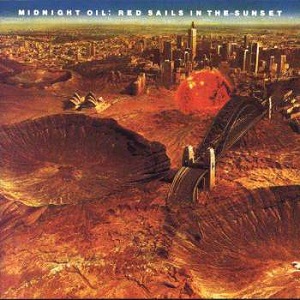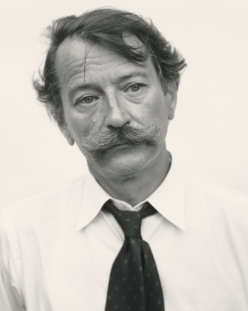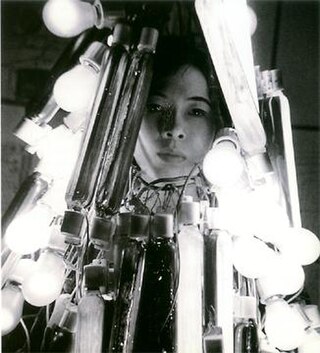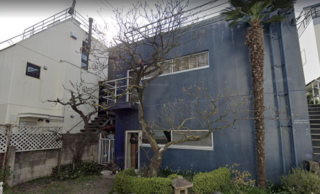Related Research Articles
Henri Chopin was a French avant-garde poet and musician.

Red Sails in the Sunset is the fifth studio album by Australian group Midnight Oil which was released in October 1984 under the Columbia Records label. It was recorded and produced in Tokyo, Japan and is significant for becoming their first No. 1 album in Australia – it also entered the United States Billboard 200. The cover image, by Japanese artist Tsunehisa Kimura, depicts Sydney Harbour after a hypothetical nuclear strike. Some of its tracks were performed live in January 1985 at a Sydney Harbour Goat Island concert to celebrate radio station Triple J's 10th birthday, which was simulcast on ABC Television and subsequently re-broadcast on their then-Tuesday night music program Rock Arena. In 2004 the film footage later became part of a DVD album, Best of Both Worlds. Red Sails in the Sunset contains the only Midnight Oil tracks with lead vocals provided by their drummer Rob Hirst, "When the Generals Talk" and "Kosciusko". The album spawned two singles, "When the Generals Talk" and "Best of Both Worlds" but neither appeared on the Australian singles chart.

Thaddeus John Szarkowski was an American photographer, curator, historian, and critic. From 1962 to 1991 Szarkowski was the director of photography at New York's Museum of Modern Art (MoMA).
Mike Parr is an Australian performance artist and printmaker and Painter. Parr's works have been exhibited in Australia and internationally, including in Brazil, Cuba, France, Germany, Hungary, Japan, Korea, Taiwan, and the United States.
David Perry was a pioneering Australian experimental and underground filmmaker, video artist, and a founding member of Ubu Films (1965). He also practised as a photographer, poster artist and painter.

Atsuko Tanaka was a Japanese avant-garde artist. She was a central figure of the Gutai Art Association from 1955 to 1965. Her works have found increased curatorial and scholarly attention across the globe since the early 2000s, when she received her first museum retrospective in Ashiya, Japan, which was followed by the first retrospective abroad, in New York and Vancouver. Her work was featured in multiple exhibitions on Gutai art in Europe and North America.
Kathy Smith is an Australian independent animator, painter, new media artist, and Professor with the USC School of Cinematic Arts. Smith chaired the John C. Hench Division of Animation & Digital Arts from 2004 - 2009 & 2010 - 2014.
Mark Simmonds was a New Zealand-Australian jazz tenor saxophonist, composer, and leader of the group The Freeboppers. Born in Christchurch, New Zealand, he moved to Sydney, New South Wales, Australia when he was 10 years old.

Klaus Biesenbach is a German-American curator and museum director. He is the Director of the Neue Nationalgalerie, with Berggruen Museum and Scharf-Gerstenberg Collection, as well as the berlin modern under construction.
John George Conomos was an Australian artist, critic and writer, and Associate Professor and Principal Fellow at Victorian College of the Arts, Faculty of Fine Arts and Music, the University of Melbourne.

Chris Meigh-Andrews is a video artist, writer and curator from Essex, England, whose work often includes elements of renewable energy technology in tandem with moving image and sound. He is currently Professor Emeritus in Electronic & Digital Art at the University of Central Lancashire and Visiting Professor at the Centre for Moving image Research (CMIR) at the University of the West of England.
Linda Dement is an Australian multidisciplinary artist, working in the fields of digital arts, photography, film, and writing non-fiction. Dement is largely known for her exploration of the creative possibilities of emergent technologies such as the CD-ROM, 3-D modelling, interactive software, and early computing.
Justine Cooper is an Australian artist and currently residing in New York. Cooper is known for her paintings and photographs which explore themes of identity, history and memory.

Destiny Deacon HonFRPS was an Australian photographer, broadcaster, political activist and media artist. She exhibited photographs and films across Australia and also internationally, focusing on politics and exposing the disparagement around Australian Aboriginal cultures. She was credited with introducing the term "Blak" to refer to Indigenous Australians' contemporary art, culture and history.
Patricia Larter (1936–1996) was an Australian artist who worked across mail art, video, photography, performance and painting. She was "one of the leading figures in the movement known as 'international mail art'". She is credited with coining the term "femail art" that was taken up by other mail artists around the world.
Josephine Starrs is an Australian artist who creates socially engaged art focusing on human relationships to new technologies, nature and climate change. Her video and new media work has been exhibited in Australia and at international art exhibitions. She was a Senior Lecturer in Media Arts at Sydney College of the Arts, University of Sydney until 2016.
John Gillies is an Australian visual artist, filmmaker and musician, particularly known for his "multi-layered and complex" video works and installations. He has also curated a number of video art programs.
Janet Burchill is an Australian contemporary artist. She is known for her work across multiple disciplines such as painting, sculpture, installation, film, and her continued collaboration with Jennifer McCamley since the mid-1980s. Notably, Burchill's work has been collected and included in the Cruthers Collection of Women's Art.
Mark Titmarsh is a contemporary Australian painter. His work involves permutations of painting, sculpture, installation, screen media, performance and writing. In 2017, he published a book called Expanded Painting.

Video Gallery SCAN was the first Japanese art gallery exclusively dedicated to the exhibition, preservation, and promotion of video art. Founded in 1980 by the female performance artist and fog sculptor Fujiko Nakaya, SCAN was an independent, artist-run organization situated in Tokyo's Harajuku neighborhood. While small in scale, the Gallery was a multifunctional space whose services included a video distribution service, video archive & library, screening studio, and exhibition area.
References
- ↑ Perkins, Mathew (ed), Video Void: Australian Video Art, Australian Scholarly, 2014 ISBN 978-1-925003-79-6
- 1 2 Meigh-Andrews, Chris, A History of Video Art, second edition, Bloomsbury Publishing 2014, ISBN 978-0-8578-5177-2
- ↑ Callas, Peter, 'Interlaced Places: Video in Tokyo and Sydney in the Eighties', in Alessio Cavallaro, (ed), Peter Callas: Initialising History, dLuxedition.one, Sydney 1999, ISBN 0-646-37894-5
- 1 2 'Peter Callas: Interviewed by Nicholas Zurbrugg' in Electronic Arts in Australia Zurbrugg, Nicholas (ed), Continuum, 1994 ISN 1030-4312
- ↑ Meigh-Andrews, Chris, A History of Video Art, second edition, Bloomsbury 2014, ISBN 978-0-8578-5177-2
- ↑ Callas, Peter, 'Interlaced Places: Video in Tokyo and Sydney in the Eighties', in Alessio Cavallaro, (ed), Peter Callas: Initialising History, dLuxedition.one, Sydney 1999, ISBN 0-646-37894-5
- 1 2 3 Cavallaro, Alessio (ed) Peter Callas: Initialising History, dLuxedition.one, Sydney 1999, ISBN 0-646-37894-5
- ↑ https://www.moma.org/momaorg/shared/pdfs/docs/press_archives/7313/releases/MOMA_1994_0099_69.pdf?2010 Museum of Modern Art, accessed 18 September 2017
- ↑ "An Eccentric Orbit: Video Art in Australia (Tour) | Scanlines".
- 1 2 "An Eccentric Orbit: Video Art in Australia 1980-1994 :: Museum of Contemporary Art Australia". Archived from the original on 5 July 2017. Retrieved 1 August 2017.
- ↑ http://videoartchive.org.au/pcallas/ Australian Video Art Archive, accessed 8 September 2017
- ↑ http://videoartchive.org.au/pcallas/ Australian Video Art Archive, accessed 18 September 2017